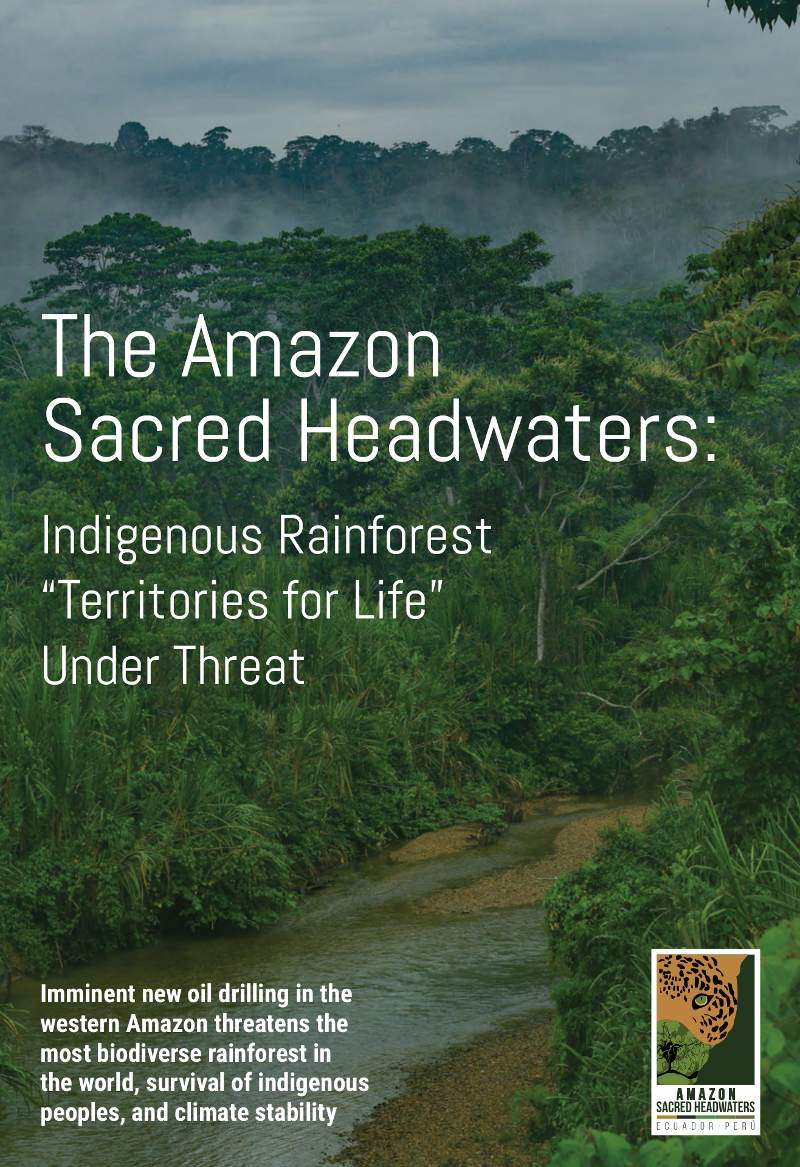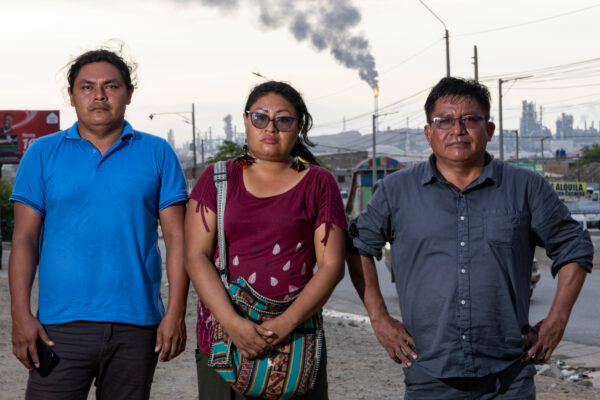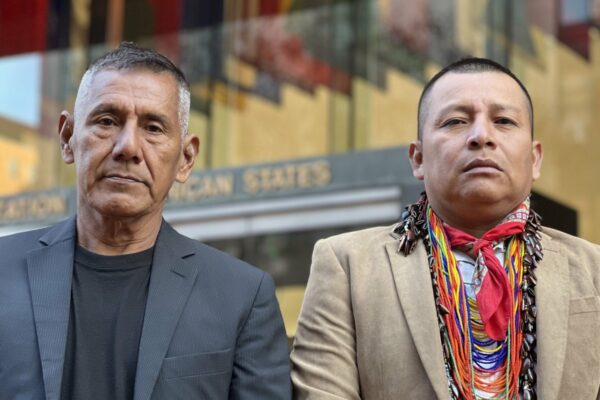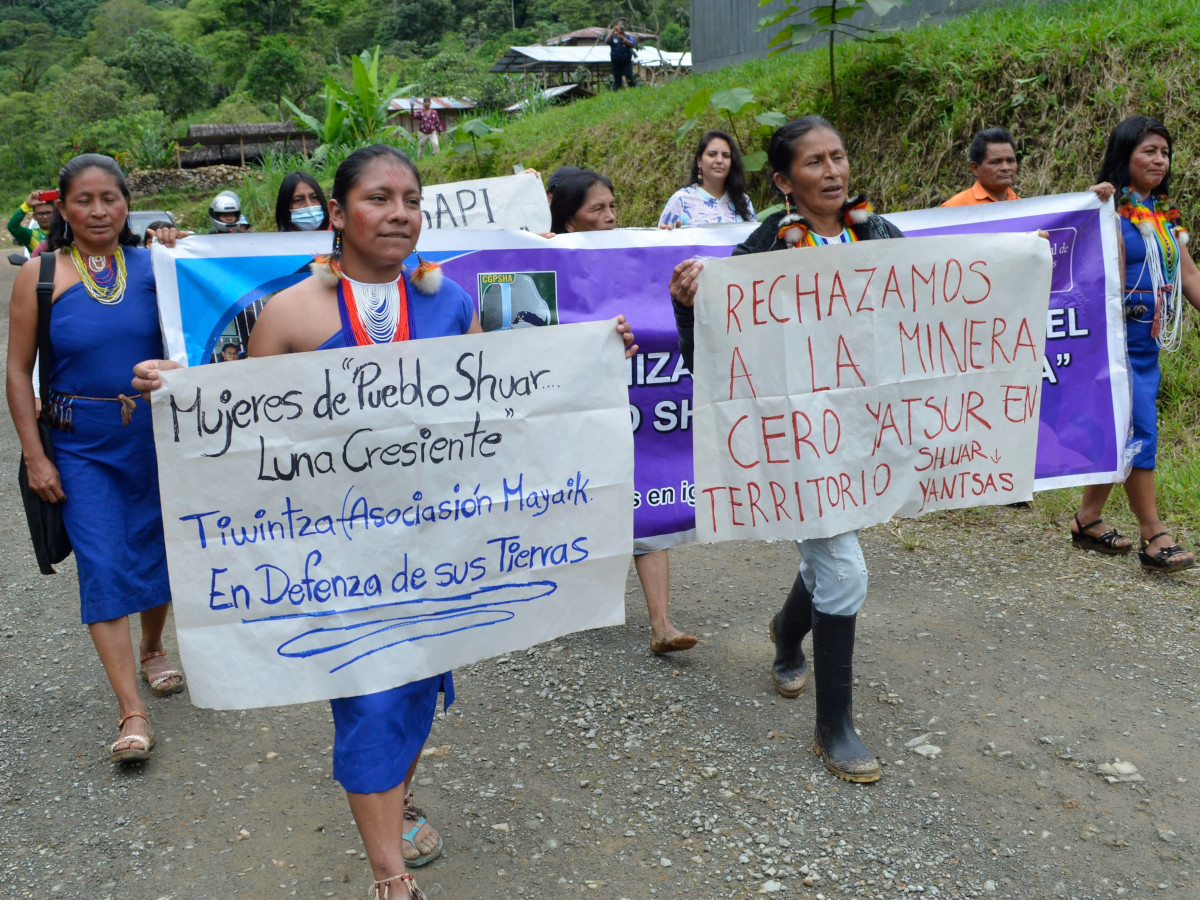Download as PDF (6.9 MB) | Versión en español
Executive Summary
The Amazon in Crisis
In the summer of 2019, fires raged across the Amazon from Brazil to Bolivia, ravaging an ecosystem already close to collapse from threats including deforestation, illegal logging, large-scale industrial extraction and agribusiness expansion. The viral images of man-made fires provoked international outrage and concern over the fate of the Amazon, its peoples, and the implications of losing an ecosystem essential for survival on this planet. But at a time when the world needs to be racing to protect the Amazon, a new oil boom in the headwaters of the mighty Amazon River in Ecuador and Peru puts this area, known as the Amazon Sacred Headwaters, in great peril.
The Amazon Sacred Headwaters
The Sacred Headwaters in the Upper Amazon is one of the birthplaces of the Amazon river. Spanning 30 million hectares (74 million acres) in Ecuador and Peru, this area is home to nearly 500,000 indigenous people from 20 nationalities (including peoples in voluntary isolation). It is the most biodiverse terrestrial ecosystem on the planet, and it represents both the hope and the peril of our times.
The reason this rainforest region remains largely free of industrial extraction is due to the successful efforts of indigenous peoples to protect and defend their territories. Here, indigenous peoples have stopped industrial waterways, dams, roads, and drilling plans by companies including Chevron, ConocoPhillips, ARCO, Andes Petroleum, ENI, Petrobras, CGC, and Talisman Energy, among others. Their efforts have stopped extraction and bolstered indigenous rights throughout the region and beyond. From their communities in the rainforest to the streets of the capital cities of Quito and Lima, or in dialogue with state governments, indigenous peoples in the Sacred Headwaters region continue to adamantly express their opposition to any new oil drilling.
But a new push by Ecuador and Peru to expand extraction and auction new oil blocks in this area threatens indigenous peoples and their Amazonian territories. In response, indigenous nations are joining together in a new initiative, led by the regional Amazonian indigenous confederations of both countries, CONFENIAE and AIDESEP respectively, calling for an immediate moratorium on new extraction and exploration, while pursuing a just transition away from fossil fuel dependency, to post-petroleum economies that elevate indigenous solutions and respect their rights and autonomy.
Oil Expansion in the Last Place on Earth it Should Happen
Millions of acres in the Amazon Sacred Headwaters region are now under imminent threat from the expansion of fossil fuel production into intact rainforest, testing the resiliency of an ecosystem that survived the ice age. Ecuador has announced plans to leave OPEC by 2020 to boost production and has reformed its hydrocarbon contract structure to attract new investment. Peru hopes to pass hydrocarbon reform in 2020 to expedite drilling.
But the Amazon biome is on the brink. Scientists warn it is close, or has already passed, a tipping point of no return, which will convert it from carbon sink to carbon source. Drilling for new fossil fuels in the most biodiverse rainforest on the planet – a forest eco- system that regulates essential planetary ecosystem services like the hydrologic and carbon cycles – is a recipe for disaster.
New and ongoing oil extraction also threatens the very livelihood and cultures of indigenous peoples, some of whom live in voluntary isolation. For them, oil production and deforestation are existential threats to their survival as a people.
The threat that new oil extraction poses to indigenous peoples, biodiversity, and standing forests in the Sacred Headwaters region makes leaving fossil fuels in the ground here a planetary priority.
A Huge Climate Opportunity
Ecuador and Peru’s plan to greatly expand oil production comes at a time of climate crisis. The science is clear: the world must begin a rapid phase out of fossil fuel production, and keep oil in the ground, to have the best chance of meeting the Paris agreement target goal of restricting global temperature rise to 1.5 °C.
The oil industry is a major driver of deforestation in the western Amazon, both directly and by carving out new roads that facilitate access by other extractive industries like agribusiness and mining, which then further drive deforestation. Expanding oil production and looking for new crude reserves – unburnable carbon from a 1.5 °C climate scenario – underneath standing forests that help mitigate climate change by sequestering carbon, will greatly exacerbate climate disruption and devastate the livelihoods and cultures of hundreds of thousands of indigenous peoples. A new report by the UN Environmental Program and leading researchers revealed a gap between new oil production and country climate commitments. It found governments are planning to produce 50% more oil, gas, and coal by 2030 than is consistent with the Paris Agreement, a dangerous discrepancy that threatens climate stability. Drilling in the Amazon Sacred Headwaters will only generate less than two months of the world’s oil supply, but will cause irreparable damage locally and globally.
Keeping 5 billion barrels in the region underground is equivalent to avoiding over 2 billion metric tons of C02 emissions, and maintaining the integrity of the living forest is equivalent to 4 billion metric tons of carbon. This collectively represents the equivalent energy use of 200 million U.S. homes for 10 years.
China, California, Chile, Major Businesses and Finance Institutions All Connected to the Problem
A massive portion of the existing and expanded crude oil production is being used to pay off billions in loans to China – a country with a stated ambition to advance an ecological society. Over 50% of the crude oil from the Western Amazon goes to California refineries – much of it used to fill up the gas tanks of one of the most progressive geographies on the planet. Chinese and international banks and finance institutions are funding the build-out of oil drilling in the region and major brands are fueling their fleets with the spoils.
Still Time: An Indigenous-Led Bi-National Conservation Vision
Fortunately, there is still time to protect this critical area and there is an indigenous-led conservation effort underway that is a true model for our time. Similar to a Green New Deal, the Amazon Sacred Headwaters Initiative seeks to usher in a new era of clean, renewable energy, reduce fossil fuel dependence, and create a just transition for the economies of their countries that supports the indigenous solu- tions that have helped protect this area for millennia.
Key Actions:
- The governments of Ecuador and Peru should declare the Napo, Pastaza, and Marañon River basins as a special region of global importance and off-limits to extraction and industrial scale “development.”
- National governments, inter-governmental bodies, and international civil society should support indigenous peoples in developing and implementing Life Plans and bioregional plans.
- National governments, multi-national corporations and international investors should respect indigenous nationalities’ rights to autonomy, self- determination, and territory, as detailed in the United Nations Declaration on the Rights of Indigenous Peoples (UNDRIP).
- In coordination with Amazon Sacred Headwaters Initiative, Ecuador and Peru should support creation of international, independent non market fund to protect the Amazon Sacred Headwaters and keep oil in the ground.
- International investors and lenders should immediately shift capital out of any company or project related to oil exploration or extraction; a key place to begin that shift is with the companies and projects operating within the Sacred Headwaters region, as well as any and all companies profiting from the violation of the rights of indigenous peoples.
This report is a wake-up call and shines a light on an opportunity that Ecuador, Peru, and the world must seize. It carries a message straight from the people whose cultures and ways of life are connected to the future of the Amazon Sacred Headwaters. of restricting global temperature rise to 1.5 °C. The oil industry is a major driver of deforestation in the western Amazon, both directly and by carving out new roads that facilitate access by other extractive industries like agribusiness and mining, which then further drive deforestation. Expanding oil production and looking for new crude reserves – unburnable














